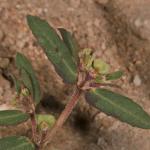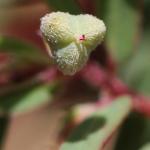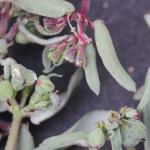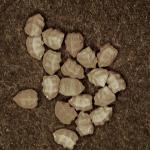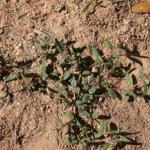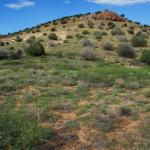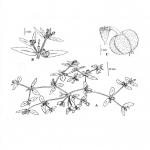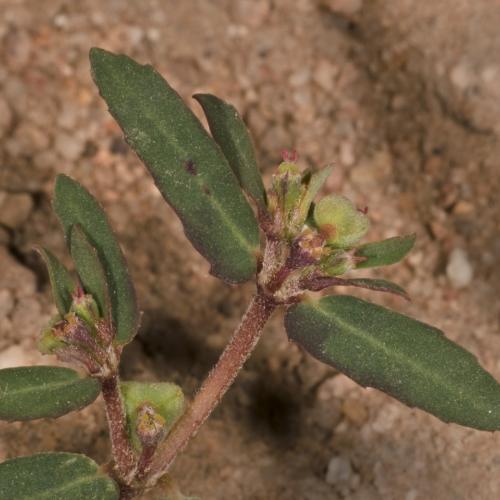Euphorbia rayturneri (Ray Turner's Spurge)
NONE
| USFWS | State of NM | USFS | BLM | Navajo Nation | State Rank | Global Rank | R-E-D Code | NMRPTC Status | Strategy Status |
|---|---|---|---|---|---|---|---|---|---|
| S1 | G1 | 3-3-3 | R | SS |
| Overall Conservation Status | Documented Threats | Actions Needed |
|---|---|---|
| WEAKLY CONSERVED | No Information |
Additional field searches to determine rarity |
Prostrate annual herb with several primary stems extending radially from a slender taproot; stems to 15 cm long, terete, strigulose with white recurved hairs 0.1-0.2 mm long, internodes 0.6-2.2 cm long; leaves opposite, stipules interpetiolar, separate, filiform, 0.6-0.9 mm long, pilose, petioles 0.5-0.9 mm long, strigulose, blade ovate to elliptic, often slightly falcate, 0.5-1.1 cm long, 0.2-0.5cm wide, base asymmetrical, cordate to oblique, apex acute, upper surface glabrescent with scattered hairs, often with a red spot towards the center, lower surface strigulose, margin sharply serrulate to sometimes subentire; cyathia solitary, peduncles 0.5-1.6 mm long, strigulose, involucre obconical 0.9-1.2mm long, 0.8-1.2 mm wide, outer surface strigulose, lobes subulate, 0.2-0.4 mm long, pilose, glands 4, circular to transversely oblong, 0.2 mm long, 0.2-0.3 mm wide, green, yellow or light pink, convex, appendages absent or reduced to a narrow margin on the outer portion of the gland, gynophore glabrous, exserted from the involucre 1.4-1.8 mm; staminate flowers 5-8; ovary 3-lobed, strigulose-canescent, styles undivided, 0.3-0.4 mm long, pink to red, glabrous; capsules oblate, 3-lobed, 1.7-2.0 mm long, 2.2-2.7 mm wide, strigulose; seeds broadly ovoid, essentially triangular in cross-section, 1.2-1.4 mm long, about 1 mm wide, tan to grayish when immature, becoming brown-blackish, apex a low, blunt point, base truncate, with 2 well-defined transverse ridges not passing through the dorsal keel.
Only three other species in Euphorbia sect. Anisophullum (genus Chamaesyce) in New Mexico have entire styles, E. revoluta Engelmann [Chamaesyce revoluta (Engelmann) Small], E. indivisa (Engelmann) Tidestrom [C. dioica (Kunth) Millspaugh] and E. stictospora Engelmann [C. stictospora (Engelmann) Small]. Euphorbia revoluta is glabrous and has linear leaves with equilateral bases. Euphorbia indivisa has very definite glandular appendages, the proximal pair often obscuring the capsule and greatly exceeding the distal pair. Euphorbia stictospora has spreading pubescence and seeds varying from almost smooth to rugulose, dimpled or with inconspicuous transverse ridges.
New Mexico: Grant, Hidalgo and Luna counties.
Desert grassland; 1400-1700m (4590-5580 ft.)
The specific epithet rayturneri honors Dr. Raymond M. Turner, Emeritus Professor, Geosciences Department, University of Arizona.
The collection site of the 1996 specimen was given only as Hidalgo County, S of Animas, Gray Ranch. The precise location is unknown but no further records of the taxon have been reported from Hidalgo County. The collection site of the 1981 collection (originally determined as Euphorbia supina Rafinesque) was precisely located in Luna County, but numerous visits to the site in 2009 produced no additional specimens. The Grant County population is restricted to an area of about one hectare. An informal survey in September 2009 revealed 10-12 plants. A survey of the area in September of 2013 after good summer rains noted several dozen plants. The area is not grazed and is being protected by the landowners, but the small size and fragility of this population makes this taxon a strong candidate for conservation concern.
*Steinmann, V.W. & Eugene Jercinovic. 2013. Euphorbia rayturneri (Euphorbiaceae), a New Species from Southwestern New Mexico, United States. Novon 22 (4): 482–485.
For distribution maps and more information, visit Natural Heritage New Mexico

